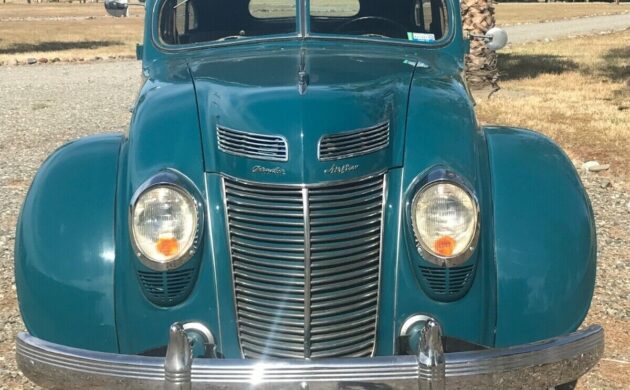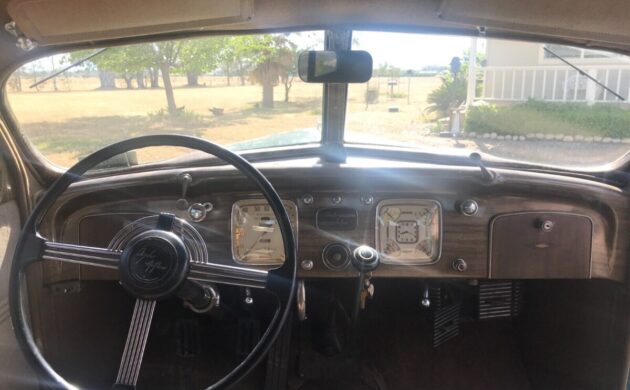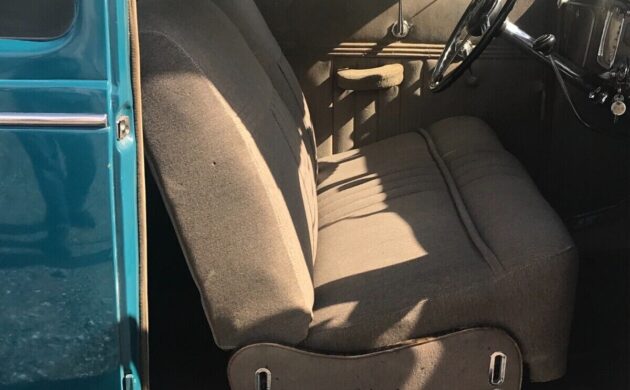The Chrysler Airflow, along with the companion Desoto Airflow, was the first full-size American production car to use aerodynamics as a basis for building a sleeker automobile. Minimizing air resistance was key to the auto’s design. It was considered an engineering success but a commercial failure due to a lack of consumer acceptance. This high-end Imperial Eight is one of few remaining and wears an older restoration with recent updates. Located in Chico, California, this interesting car is available here on eBay for $75,000 although you can make an offer. Thanks to Bill Croker for bringing this cool tip our way!
Chrysler engineers, with an assist from aviation’s Orville Wright, conducted a series of wind tunnel tests to see what body shapes were the most efficient for automotive design. They even built an in-house tunnel to determine the final shape for the Airflow. But pundits like General Motors were nervous about the competition and worked to undermine their reputation. Just six months into the 1934 selling season, Chrysler could already see that the public was not taking to the car, mainly because of its looks. After three years of production, Chrysler retired the autos in favor of more “conventional” styling wisdom.
Most Airflow production was devoted to 4-door sedans. According to the seller, the upscale Airflow Imperial Eight in 2-coupe fashion saw an average annual output of about 200 units. We’re told that only about 25 of the coupes exist today from 1934-36 and 10 of the 1937s have survived. So, this makes the seller’s auto a rare find indeed, regardless of condition. All the remaining Airflow Imperials are said to be listed in the Classic Car Club of America (CCCA) register.
These Imperial Eights were powered by a flathead eight-cylinder engine that displaced 323 cubic inches with an output of 125 hp. We’re told this Airflow runs very well with factory automatic overdrive and will cruise along effortlessly at north of 70 mph. It stops well, too, with power brakes. We don’t know how long ago the car was restored, but recent updates include the following:
- Rebuilding the carburetor and flushing the fuel system; a new electric fuel pump has been installed
- Redoing the brakes including the master cylinder, wheel cylinders, and brake lines
- Refreshing the generator, voltage regulator, and a variety of related cables and relays
The body looks to be quite tidy with no signs of damage or rust and the Parrot Blue paint is described as “driver quality” so it’s not perfect but very presentable. The indicated mileage is 76,000, but there are no claims if that’s accurate. The automobile is said to be complete, and nothing needs any immediate attention. This Chrysler looks to be a nice piece of automotive history for anyone to own, as long as the budget is there to acquire it.







Always liked the Airflow cars, it was a design the public didn’t care for. The concept was solid though just a shame it was a bust. This one is a rare one from the write up.
There is a stunning example of this car at the Revs Institute in Florida. Wildly forward thinking at the time. And very nice interior as well.
Great looking Airflow. The market for prewar cars like this is shrinking a little every year. The values are also dropping with demand.
Prewar cars like this are not that pleasing to drive for many of today’s younger buyers.
The 3 spd manual transmission, coupled with no power assist on steering and brakes makes them feel very primitive and ungainly compared to later cars.
Unless the prospective buyer is found with deep pockets and a specific desire for a 2 door ’37 Airflow, I think this will be a hard sell at $75K.
Cars of this ilk tend to be “old man” cars (I resemble that remark) that typically sit parked in collections for years until the inevitable estate sale auction.
People tend to want to buy cars that they couldn’t afford when they were young. Not too many buyers left that wish they had a ’37 Airflow. Come to think of it, there were not too many buyers that ever wanted them. They were a major sales flop.
I love these, but would it be heresy to restomod it around the edges-stance, modern wheels/moose drivetrain?
What a great find! I have to concur with previous posts however the market for such gems are, unfortunately, dying off as the boomer crowd heads to the great used car lot in the sky. I have my pop’s 1939 Imperial, love it and drive it on sunny days in the summer but as also mentioned above, it is a handful to drive. Such a shame too as the cars are automobile history and this example is truly a rare beast but I fear the price tag for admission is put of the bounds of today’s classic market. Best of luck though! In my case I have a couple young car nuts I will be leaving our car too in hopes they will cherish it as 2 previous generations of our family have done…..
Back in the Eighties I was at a car auction in Orange County California, I was putting my ’60 Caddie Limo through and in front of me was a 1938?De Soto Airflow…..beautiful car……..sold for less than ten grand! In front of that was a sweet ’60 Tbird with a metal sliding sunroof………..some things you never forget.
On a related issue Bucky Fuller may have beat the production companies with his Dymaxion though I d rather have the Chrysler or the De Soto.
I thought these cars didn’t bring much but in the last Hemmings there’s a pic of a similar Airflow that brought over $100K at auction.
Just because someone has a list of 10 cars doesn’t mean that’s all in the world. There could be others around that are not aware of that organisation that holds the list. I always take these claims with a grain of salt.
Beautiful car. I would love to own it, but unfortunately, I can’t afford 75K and don’t believe I would ever recoup my money if I did pay that much. I have a gorgeous 38 Buick Sport Coupe. The younger generation doesn’t even look at it. They are into the 70’s and 80’s muscle.
The AACA is still a huge organization.
Curiously, in the early to mid-thirties many other products featured “airflow” styling that stayed in fashion for a number of years. Specifically, home radios – of which many yet survive – helped set the stage for Chrysler and Desoto airflow styling. Many of those radios are overwhelmingly aerodynamic looking. Bakelite as well as other plastics made them easy to produce, inexpensive, and consequently abundant. Why most of the motoring public didn’t jump on the bandwagon and favor those same styles seems a mystery. Just an opinion. I sure would like that Chrysler in my driveway!
My dd wo was the right age (born 1909) hated these cars even though he was mostly a Mopar and Buick man. I recall conversations with him saying what a flop and disappointment they were. He also didn’t like Desoto for whatever reason I’m not sure. I’ve never had good luck with Mopar cars with the exception of my wife’s 87 Dodge Diplomat, it was a very nice, comfortable and dependable car until she totaled it on her way to work one morning back in 95. She bought the car brand new off the showroom floor, and really babied it.
Very nice presentation although I don’t know that they’re going to get the $75,000 they’re looking for for it. As far as why they did not sell, I think a lot has to do with the headlights, which were both narrow set and had trim surrounds that made them look like your Great Aunt Judy with the baggy eyes, or perhaps Tommy Lasorda.